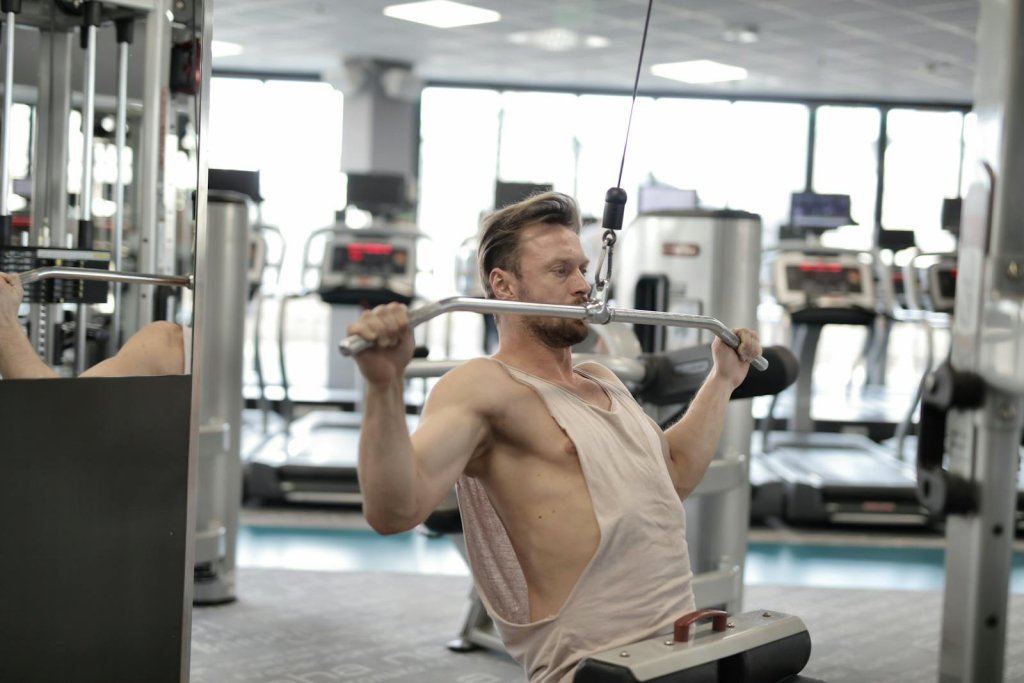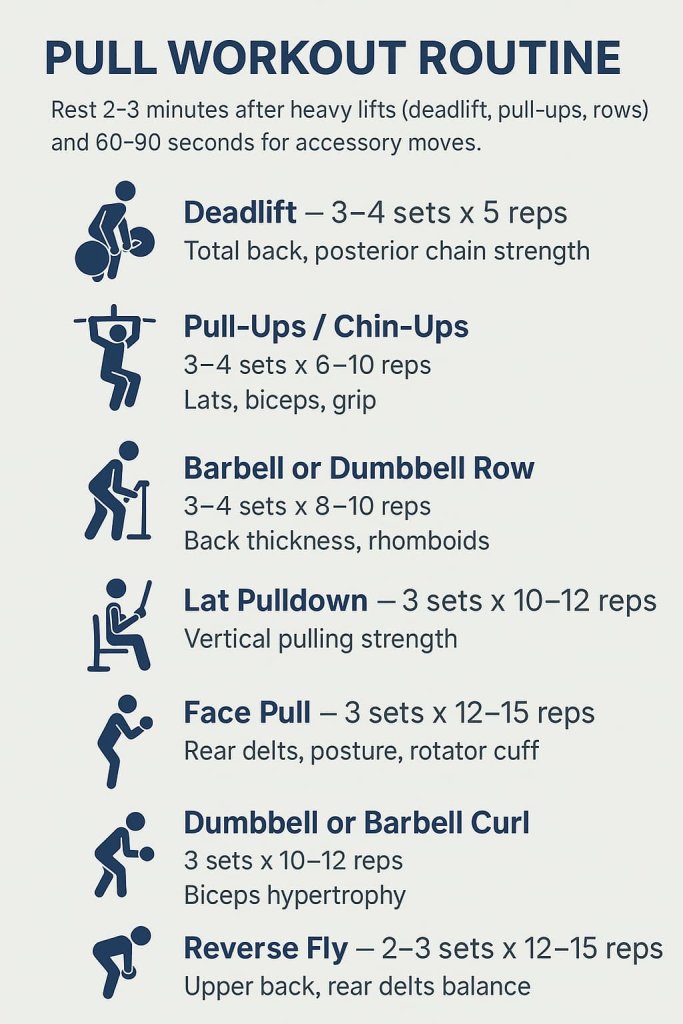A pull workout routine targets the muscles responsible for pulling movements—mainly the back, biceps, and rear shoulders. It’s one of the three pillars of the classic Push–Pull–Legs (PPL) split and plays a critical role in building strength, size, and posture.

Whether you’re a beginner learning lat pulldowns, an intermediate lifter building row strength, or an advanced athlete chasing weighted pull-ups, pull day is where you sculpt a wide back, powerful arms, and long-term resilience.
Understanding how to structure your pull workout is key. The right routine combines compound lifts for strength, vertical pulls for width, horizontal pulls for thickness, and accessory moves for balance and injury prevention.
Benefits of Pull Workouts
Pull workouts are not just for building muscle—they improve functional strength and health:
- ✅ Back width and thickness – Lats (pull-ups, pulldowns) add width; rows and deadlifts add density.
- ✅ Arm and grip strength – Biceps and forearms get stronger with every pull.
- ✅ Better posture – Face pulls and reverse flys counteract desk slouch.
- ✅ Joint health – Balanced training reduces shoulder injuries.
- ✅ Carryover strength – Improves pushing lifts (bench, overhead press) by stabilizing the shoulder girdle.
Pull Workout Routine (Sample Plan)
Here’s a proven pull workout routine that combines heavy compounds, vertical pulls, horizontal pulls, and isolation exercises for complete back and arm development. This routine is recommended by top fitness sources like StrengthLog, Gold’s Gym, and Barbell Medicine (2025).

| Exercise | Sets × Reps | Primary Focus |
|---|---|---|
| Deadlift | 3–4 × 5 | Total back, posterior chain strength |
| Pull-Ups / Chin-Ups | 3–4 × 6–10 | Lats, biceps, grip |
| Barbell or Dumbbell Row | 3–4 × 8–10 | Back thickness, rhomboids |
| Lat Pulldown | 3 × 10–12 | Vertical pulling strength |
| Face Pull | 3 × 12–15 | Rear delts, posture, rotator cuff |
| Dumbbell or Barbell Curl | 3 × 10–12 | Biceps hypertrophy |
| Reverse Fly | 2–3 × 12–15 | Upper back, rear delts balance |
👉 Rest 2–3 minutes after heavy lifts (deadlift, pull-ups, rows) and 60–90 seconds for accessory moves.
Core Exercises in a Pull Workout
1. Deadlift – 3–4 × 5
Why it matters: The king of pulling lifts, targeting spinal erectors, traps, glutes, and hamstrings.
Pro tip: Perform first when you’re freshest. Keep your back neutral to avoid injury.
2. Pull-Ups / Chin-Ups – 3–4 × 6–10
Why it matters: Builds lats and arm strength.
Pull-ups emphasize lats, chin-ups emphasize biceps. Progress by adding weight once you master bodyweight sets.
3. Barbell or Dumbbell Row – 3–4 × 8–10
Why it matters: Creates mid-back thickness and overall pulling power.
Variations: barbell bent-over row (strength), T-bar row (mass), dumbbell row (unilateral correction).
4. Lat Pulldown – 3 × 10–12
Why it matters: Ideal beginner alternative to pull-ups.
Focus on slow, controlled pulls with full range of motion.
5. Face Pull – 3 × 12–15
Why it matters: Strengthens rear delts, traps, and rotator cuff muscles—essential for shoulder health and posture.
Evidence: Men’s Health (2025) notes face pulls as one of the most effective corrective upper-back exercises.
6. Bicep Curls – 3 × 10–12
Why it matters: Directly targets the biceps, complementing compound lifts.
Options: barbell curls (mass), hammer curls (forearms), preacher curls (strict isolation).
7. Reverse Fly – 2–3 × 12–15
Why it matters: Finisher for upper back and rear delts, balancing chest-dominant push training.
Use light dumbbells or cables for control.
Structuring Pull Days in Your Routine
Pull days fit naturally into a Push–Pull–Legs split:
- Day 1 – Push (chest, shoulders, triceps)
- Day 2 – Pull (back, biceps, rear delts)
- Day 3 – Legs (quads, hamstrings, calves)
- Repeat for 6 days, or rest for 3-day cycles.
Beginners → 1 pull day per week.
Intermediates → 2 pull days (strength + hypertrophy).
Advanced lifters → Up to 3 pull days per week, with varied focus.
Pull Workout Variations by Level
Beginner Pull Routine (2 Days/Week)
- Lat Pulldown – 3×12
- Seated Cable Row – 3×12
- Dumbbell Curl – 3×12
- Face Pull – 2×15
👉 Focus: Learn form, build mind–muscle connection.
Intermediate Pull Routine (3 Days/Week)
- Deadlift – 4×5
- Pull-Ups – 3×8
- Barbell Row – 4×8
- Face Pull – 3×12
- Hammer Curl – 3×10
👉 Focus: Add compound lifts, progressive overload.
Advanced Pull Routine (4–5 Days/Week)
- Weighted Pull-Ups – 4×6
- Barbell Deadlift – 4×5
- T-Bar Row – 4×8
- Seated Cable Row – 3×10
- Reverse Fly – 3×12
- Barbell Curl – 4×8
👉 Focus: Combine heavy strength and high-volume hypertrophy.
Pro Tips for Pull Day
- Warm up: Use resistance bands, scapular pull-ups, light rows.
- Prioritize heavy lifts early (deadlifts, pull-ups, rows).
- Balance vertical and horizontal pulls for full back development.
- Include rear delt work every pull session for posture.
- Apply progressive overload weekly (weight, sets, reps).
- Control tempo: Avoid swinging during curls or rushing pulldowns.
People Also Ask (FAQs)
1. How many pull workouts per week should I do?
1–2 sessions per week for beginners and intermediates; 2–3 for advanced lifters.
2. Are pull-ups better than lat pulldowns?
Yes, for strength and muscle engagement, but pulldowns are excellent for beginners.
3. Do I need deadlifts in my pull workout?
Deadlifts are great for strength, but rows and pull-ups can also build size without them.
4. Should I train biceps on pull day?
Yes—biceps are secondary movers in pulls and benefit from isolation curls.
5. How long should a pull workout take?
Around 45–70 minutes, depending on intensity and rest.
6. Can beginners start with a pull workout?
Yes—machines like lat pulldowns and seated rows make it beginner-friendly.
7. Do I need machines for pull day?
No—barbells, dumbbells, and bodyweight are enough. Machines add variety but aren’t required.
Conclusion
A pull workout routine is essential for developing back width, arm size, and overall pulling power. By combining heavy compounds (deadlifts, rows, pull-ups) with accessory work like face pulls, curls, and reverse flys, you’ll build strength, balance, and posture.
👉 Whether you’re new or advanced, consistency and progressive overload are the keys. Try the sample pull routine in your next gym session and feel the difference in strength and size.
